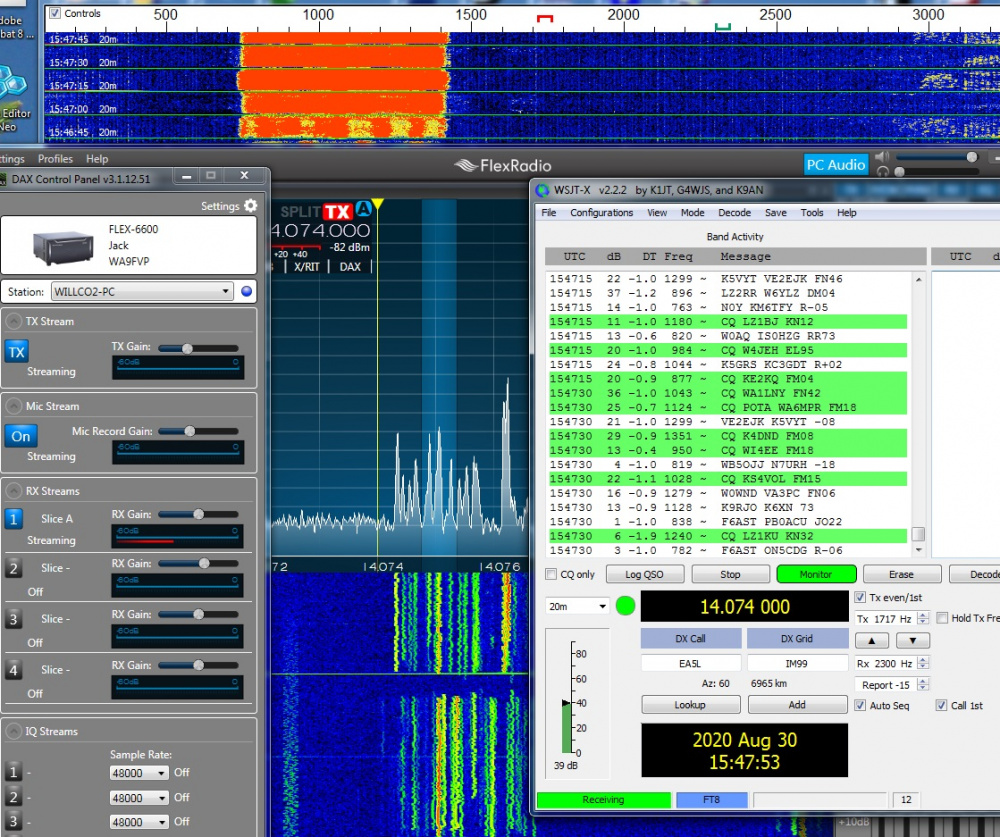SmartSDR v3.7.4 and the SmartSDR v3.7.4 Release Notes | SmartSDR v2.12.1 and the SmartSDR v2.12.1 Release Notes
SmartSDR v1.12.1 and the SmartSDR v1.12.1 Release Notes
Power Genius XL Utility v3.8.8 and the Power Genius XL Release Notes v3.8.8
Tuner Genius XL Utility v1.2.11 and the Tuner Genius XL Release Notes v1.2.11
Antenna Genius Utility v4.1.8
Need technical support from FlexRadio? It's as simple as Creating a HelpDesk ticket.
WSJT Bandwidth

I was told by a non Flex user, to bring signals out of the noise using WSJT-X, I should narrow the receivers band-width. When I do that the WSJT-X waterfall shows an over ranged level but the level indicator is normal. I can fix it by reducing the DAX receive level but I don't see any benefit in narrowing the band-width. He said "My Flex 6600 is defective". He uses TS-450 to transmit and a ELAD SDR receiver connected to the 450's I.F. to demodulate the signals.
Comments
-
It seems you have to leave the bandwidth to the 3 khz total, in order to encompass all the stations sending in the bandpass. Seems if the bandpass is too narrow, then those outside the bandpass will not decode. The waterfall inside wsjt shows all the receive stations that will decode, and it narrows as you narrow the Flex bandwidth cutting off the stations outside... The dsp coding in wsjt takes care of the individual station bandwidths. I set the level inside wsjtx according to the intructions using the level indicator to the left with the DAX receive level just as you indicated.
Regards
wb7ond
0 -
I agree. This guy lacks knowledge of the Flex radio direct sampling receiver. I tried to explain the advantages of dynamic range but he just didn’t get it. He kept insisting that a strong FT-8 carrier will cause the AGC to reduce the weak ones below the noise. I tried to tell him when the Flex AGC-T is properly adjusted, there’s no AGC action.
1 -
Also you do not show your settings for the WSJT-x waterfall display. You can adjust the sliders to optimize the waterfall reference and intensity.
I find DAX RX1 level of 36 and DAX TX level of 48 are optimal for both my 6600 and 6700 using SmartSDR 3.1.12.
Dave wo2x
0 -
I open it up quite wide. If running FT8 I open it until I reach the edge of the FT4 areas.
I decode -24 all the time. I often can't talk to them due to a lousy low antenna but I decode them all the time. I once decoded a -25 but only saw that once.
Mark WS7M
0 -
Your friend might be fooled into thinking reducing the bandwidth brings out the weak ones because signal reports in JT modes are signal to noise ratio calculated using a 2.8 kHz bandwidth. With a narrower bandwidth, the number will look "better" although nothing will really have changed. As WB7OND said, the software takes care of the issue. Likewise, with proper AGC settings, you will not have a problem with close strong signals (for the most part - nothing is perfect!).
I usually run with AGC off and set the background level to mid-scale on the "thermometer." Usually, with DAX and audio settings, mid-range on everything works out pretty well. Your mileage may vary depending on system specifics, of course.
Don't rely on the WSJT-X waterfall - it is a tuning aid, not a scope. Trust your Flex. It's not defective.
1
Leave a Comment
Categories
- All Categories
- 246 Community Topics
- 2.1K New Ideas
- 488 The Flea Market
- 7.1K Software
- 5.9K SmartSDR for Windows
- 134 SmartSDR for Maestro and M models
- 331 SmartSDR for Mac
- 243 SmartSDR for iOS
- 222 SmartSDR CAT
- 163 DAX
- 348 SmartSDR API
- 8.6K Radios and Accessories
- 6.9K FLEX-6000 Signature Series
- 766 Maestro
- 41 FlexControl
- 836 FLEX Series (Legacy) Radios
- 733 Genius Products
- 393 Power Genius XL Amplifier
- 255 Tuner Genius XL
- 85 Antenna Genius
- 229 Shack Infrastructure
- 153 Networking
- 370 Remote Operation (SmartLink)
- 120 Contesting
- 583 Peripherals & Station Integration
- 115 Amateur Radio Interests
- 813 Third-Party Software




